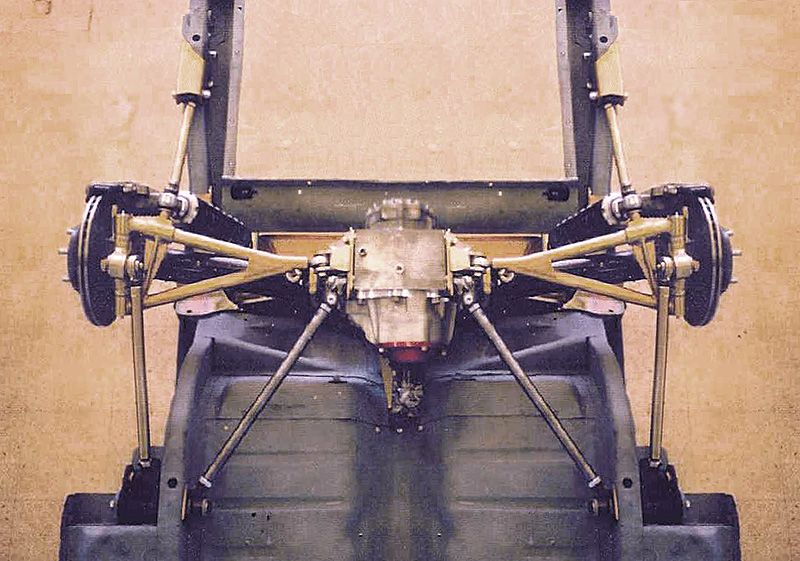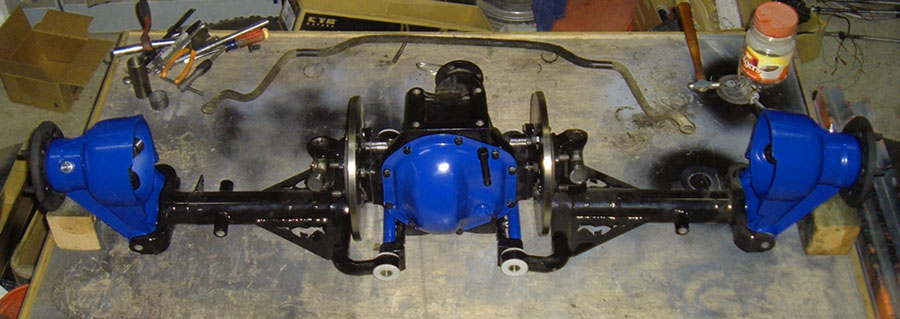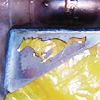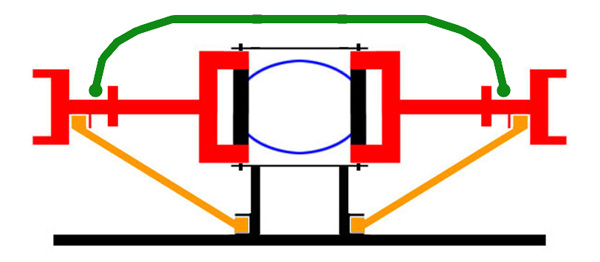

 |
 |
 |
 |
 |
You are not logged in. Would you like to login?
![]() Offline
Offline
I'd like to make an attempt at putting together a spreadsheet showing the different characteristics of a typical IRS setup that gets addressed here and expand on it . I threw something together in about 5 minutes and would like any suggestions on how to go about it and would definelty appreciate infomation to complete it.
Maybe we can come up with something simple and useful in the end.
![]() Offline
Offline

Good idea!
Roll steer? Medium I would say. Mainly due to the fact you must avoid toe out. Also would not roll steer and rear steer be the same?
Just found a better explanation of roll steer so they are really not the same by what I see. Roll steer is caused from the outside of a tire going into a cone shape and being smaller to the outside. This can be adjusted I think just by increasing negative camber, toe-in, toe-steer, anti-swaybar, tire pressure, spring rate, center of gravity. Many features an IRS has over a solid axle.
Roll steer
Roll steer also has an effect on over and understeer. Roll steer or camber thrust is the effect the change of camber has due to body roll when the car is cornering. How does this happen?
Well while cornering the tyres will take a form like the base of a cone. The wheel wants to turn around the peak of that cone. This effect makes the wheel trying to steer away from the center of the car. In a straigh line the effect does not exist. If the car is cornering more weight is transferred to the outside wheels than the inside wheels. This means the outside wheel has more influence on the car. As the outside (positive cambered) wheel tries to steer the car to the outside of the corner, the car will be understeered. If the wheels have negative camber the car will oversteer. Engineers can use this effect to create the desired grade of under or oversteering. An understeered car feels more stable as it has a tendency to correct itself. Not so with an oversteered car.
Last edited by Ralphy (11/14/2011 12:42 pm)
![]() Offline
Offline
Ralphy - camber thrust is one thing but not really a component of steering induced by suspension geometry relative to body roll.
Rear suspensions are often designed to induce a certain steering effect with body roll. For instance, a semi-elliptic leafspring suspension will typically have the springs mounted such that the axle moves forward under bump, which in a corner causes the outside wheel to steer into the turn producing roll understeer.
![]() Offline
Offline

JEM I never quit understood this, but now I do, I think. When cornering the outside rear tire takes on more weight. In a straight plain you will have the centerline of the rear axle no longer parallel to the road. A tire is not a hard solid object, the outer most point of the outer tire is compressed more than the inner. This in turn equals a smaller diameter at the outer tire edge to the center of the tire. This causes the tire to want to track in the same direction. Read 6.3.2.
Vehicle handling dynamics: theory and application
Last edited by Ralphy (11/14/2011 3:11 pm)
![]() Offline
Offline
...Hence the need for a simplified explanation.
Wow. That looks like of of my engineering books from college. If I have another nightmare about missing my final exam, it's all your fault!
![]() Offline
Offline

Basically if you stood on an axle favoring one side or the other with low pressure in the tires. the axle would turn in the direction you were standing on. Or roll a motorcycle tire and watch it go round and round faster.
![]() Offline
Offline

Characteristic how to address comments
Body role Sway bar
rigged mounting of sub frame
Poley bushings instead of rubber
Squat build it in linearly
Built in reaction
Rear Steer adjustable reactive toe
Wheel hop upper watts link
Roll steer
Lateral stability rigged mounting of differential
Control arm stability trailing arm doesn’t need to be watts to get the job done
Hub torque trailing arm and upper watts
I had levels of importance but I removed them because it all depends on what a person is trying to do. What my be of a high level of importance for one application may not matter on another.

![]() Offline
Offline
Updated
Daze, can you elaborate on the squat solutions?
![]() Offline
Offline

OK, so here is my $64 question. If you build a suspension with toe-steer, Can you alter rear toe and camber settings to zero? What I have seen, typical IRS settings include negative camber and toe-in. If you were able to compensate the negative effects in cornering with toe-steer, allowing the rear wheels to track dead straight and flat would increase speed performance in straight line driving, no?
Duane where are you! LOL!
I have been reading on roll-steer, I think some confusion has been posted by many at other sites. The best way I think to explain what I comprehend is. If you took a chassis steering in a straight line it would steer straight. Now add 500lbs. to the right rear. What this does is cone the right rear tire, smaller to the out side. This cone shape will want too make the right rear tire track right, outward. In turn the rear would go right and the chassis would go left causing over-steer.
Being that most cars have a double wishbone in front and a solid axle in the rear. The front can be tuned to remove roll-steer but the rear cannot. The solid axle can be moved fore and aft to compensate however removing this coning of the loaded tire can't be improved. An IRS does camber so the effect would be less than a solid axle chassis no mater.
Last edited by Ralphy (11/15/2011 8:43 am)
![]() Offline
Offline

Just posted and read a good point on a Vette board. The C4 toe-steer design toes the rears in under jounce and rebound unlike the Arning design. Which toes in under jounce and out at rebound. When braking hard with the Arning design the toe-out can cause a unsafe condition. With toe-steer there is no need for the rebound side to steer in the same direction as the jounce, since the loaded side becomes the dominate dictator.
Thought that was a good point.
![]() Offline
Offline

hey 37ford I like the revised spread sheet much better "area of importance" is much better than level of importance. Couple things I would change. first make an "area of importance" for each "how to address" solution.
second change up the classifications of "area of importance" and define them:
Driver-Cruiser Daily driver or other application where Ride quality is the primary goal
Street-Track Driven regularly and ride quality is important but not to the exclusion of performance
Track-Autocross Only sees race time handling is paramount ride quality is irrelevant
third I would add another category, "should be avoid for this application"
Example:
Body role Sway bar Driver-Cruiser/Street-Track/Track-Autocross N/A
rigged mounting of sub frame Track-Autocross Driver-Cruiser/Street-Track
Polly bushings instead of rubber Street-Track/Track-Autocross Driver-Cruiser
As to the "squat solutions" there are really only 3 ways to do it:
1. build in linear squat. angle the movement of the suspension so that as the suspension travels up it also travels back slightly.
2. run an IRS system EXACTLY as designed and utilize any anti-squat built in to the system. In some cases its linear and some cases it is reactive. for instance the newer Jag units are set up with the wishbnes angled slightly to create linear squat, but on the older Jag set up the bushings on the cage and the position of the trailing arms were designed to induce a little squat during suspension compression.
3. Design a squat inducing link (similar to what Jag did) problem here is to do that you either need TONS of trial and error, a degree in engineering, modeling software so you can put it all in to a computer to see exactly what is happening, or better yet ALL three. Option three is out of my league but may be an option for some.

![]() Offline
Offline

Ralphy wrote:
Being that most cars have a double wishbone in front and a solid axle in the rear. The front can be tuned to remove roll-steer but the rear cannot. The solid axle can be moved fore and aft to compensate however removing this coning of the loaded tire can't be improved. An IRS does camber so the effect would be less than a solid axle chassis no mater.
I agree totally. In an IRS you get the best of both worlds. you get independent camber (from wheel to wheel) but you can still tie the two halves together with a sway bar to reduce body roll when cornering. the result is a car that rides closer to level when cornering and also is less prone to roll-steer

![]() Offline
Offline

OK, I got an answer from Stroker427, he built his own toe-steer IRS. His car is pictured here, here are his thoughts on toe-steer from experience. Stroker is in Italy.
I "totally agree with Pappy!
Rear bump steer can be very usefull is specific conditions... even at the beginning or at the end of the corner.... but is very critical to be adjusted.
Furthermore any different track or condition needs a specific design.
For example I did a test with my car setting a good quantity of bump toe-in and rebound toe-out. This was helping a lot in a very tight autocross.... braking the toe-out helps the insetion in the corner and toe-in during acceleretion coming out from the corner was avoiding oversteer.
Anyway was very difficult to set the proper amount of toe changing.
A neutral condition is the best compromize for predictability!"
Stroker (Pier) havin a little fun.
Last edited by Ralphy (11/15/2011 5:58 pm)
![]() Offline
Offline

Hey 37ford Something happened to the new spreadsheet post you made can you re post it??
also can you add an "*" with the defenition : "highly functional but there is an easier way to accomplish nearly the same thing" then put the * next to the lower watts link. also your spread sheet idea got me thinking maybe we should make a similar page with parts lists then pros and cons so we can go in to more detail. Example
part Pro Con
inboard disc less unsprung weight harder to work on
pore cooling
solid rotor
limited upgrade options
outboard disc easier to work on More unsprung weight
parts get more cooling air harder to change the bolt pattern
vented rotor
more upgrade options
better suspension frequency
9" differential
upper watts
lower watts
tubular LCA
inboard vented rotor kit
UHMW bushings
Sway bar
any others I didn't think of

![]() Offline
Offline

I realized there were a couple more things I wanted to add, and deleted it. Then, I couldn't get it to repost.
About the *, I added a "level of difficulty" column to hopfully serve as a way to distingush the "How to address" options so that, if it's your desire, you can pick the easiest options to accomplish your area of importance. Of course, level of difficulty will vary from vehicle to vehicle and IRS to IRS, but I think we can ballpark it.
Still unsure if a lower watts link can be considered an effective wheel hop solution.
![]() Offline
Offline

that is really coming together well!!! do you think you could email me the spread sheet so I can fill in some of the blanks?? easier than trying to specify them and have you add them. Also what did you think of my second spreadsheet idea??
37ford wrote:
Still unsure if a lower watts link can be considered an effective wheel hop solution.
yes and no. I am still of the mind that most of the twisting happens where the hub meets the wishbone so the biggest fix for wheel hop is the upper watts, however if you remove the lower support there will probably be some for and aft movement that would aggravate wheel hop.
Even though some people set up a Jaguar IRS with out it, to me LCA support is not an option its required just like a half shaft or LCA so if it is required is it still a solution???
Last edited by Daze (11/16/2011 12:46 pm)

![]() Offline
Offline
Spreadsheet sent.
We should be careful trying to create all these masterful spreasheets. We might just eliminate the need for the forum.
No, I'm all for making another. How do you want to approach it? Would these be "feature preferences"?
Here's how I look at the process:
1. Deciding to use an IRS.
2. Deciding your area of importance.
3. Deciding how you want to address the problem characteristics that match your area.
4. Determining what additional measures you want to take to make it perfect for you.
The last step would include things deciding where to place the brakes. Would you rather hae the ease of maintenance or reduced unsprung weight for perfomance? It would also inclide any further upgrades like lightening the half shafts, bushing choices, beefing up the LCAs, etc.
Does this sound like a locigal approach? Is this anything like what you are thinking?
![]() Offline
Offline

I sent you a follow up email
37ford wrote:
Here's how I look at the process:
1. Deciding to use an IRS.
2. Deciding your area of importance.
3. Deciding how you want to address the problem characteristics that match your area.
4. Determining what additional measures you want to take to make it perfect for you.
The last step would include things deciding where to place the brakes. Would you rather hae the ease of maintenance or reduced unsprung weight for perfomance? It would also inclide any further upgrades like lightening the half shafts, bushing choices, beefing up the LCAs, etc.
Does this sound like a locigal approach? Is this anything like what you are thinking?
Well that sounds more like a flow chart. and is another good idea. what I was thinking was a simple pro/con chart for all the possible upgrades. similare to what I listed earlier.
Daze wrote:
part Pro Con
inboard disc less unsprung weight harder to work on
pore cooling
solid rotor
limited upgrade options
outboard disc easier to work on More unsprung weight
parts get more cooling air harder to change the bolt pattern
vented rotor
more upgrade options
better suspension frequency
9" differential
upper watts
lower watts
tubular LCA
inboard vented rotor kit
UHMW bushings
Sway bar
any others I didn't think of

![]() Offline
Offline

The latest -
Let me know if there is something you disagree with or something I need to add.